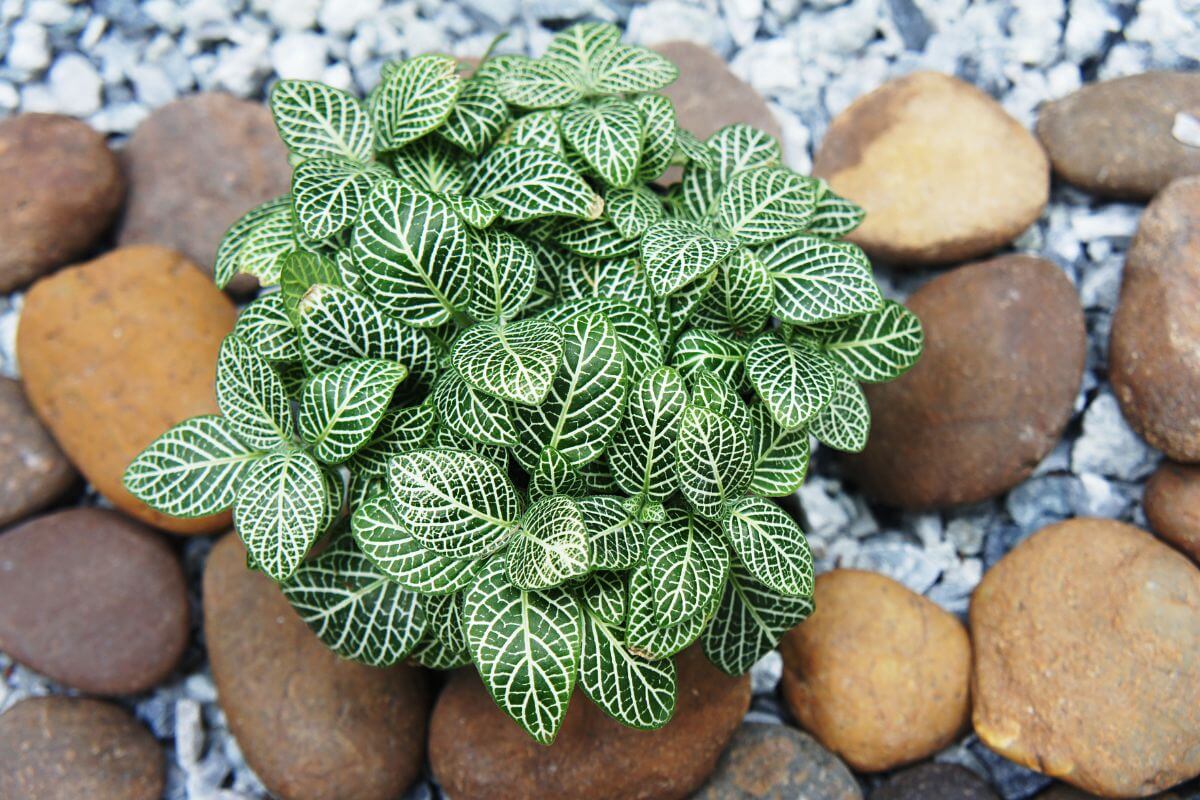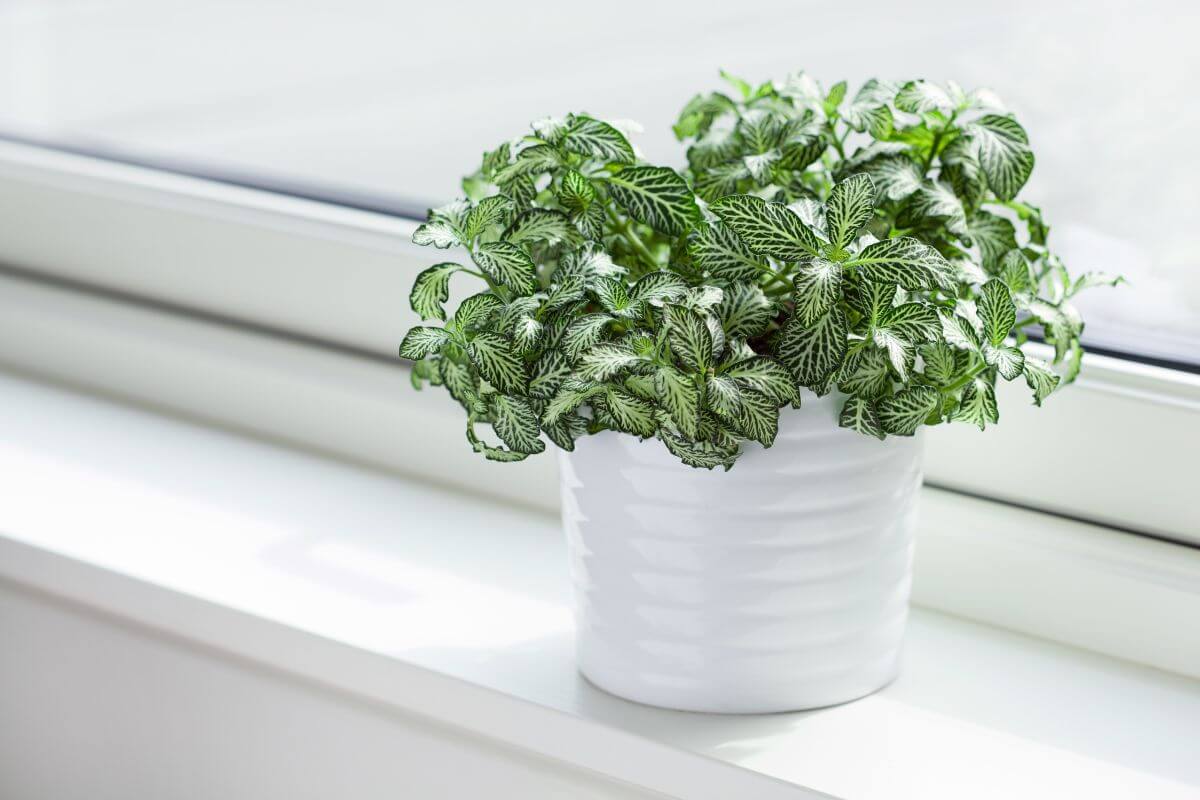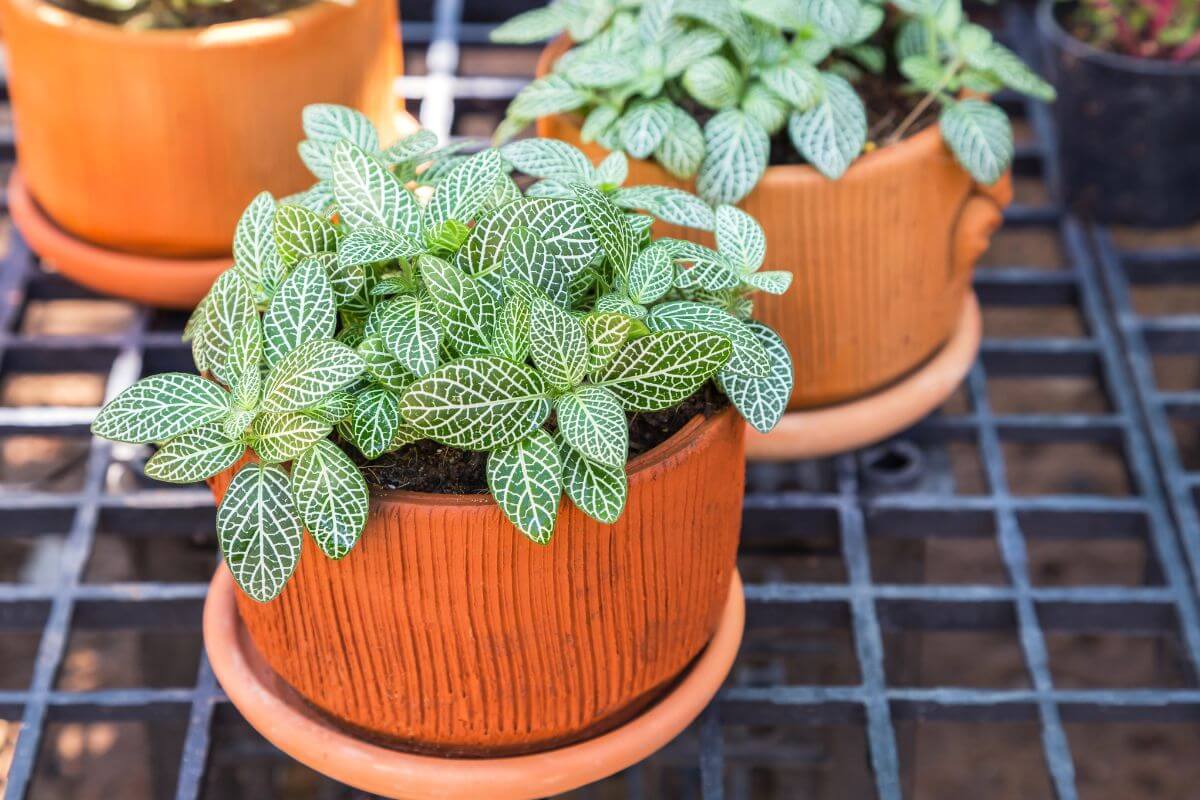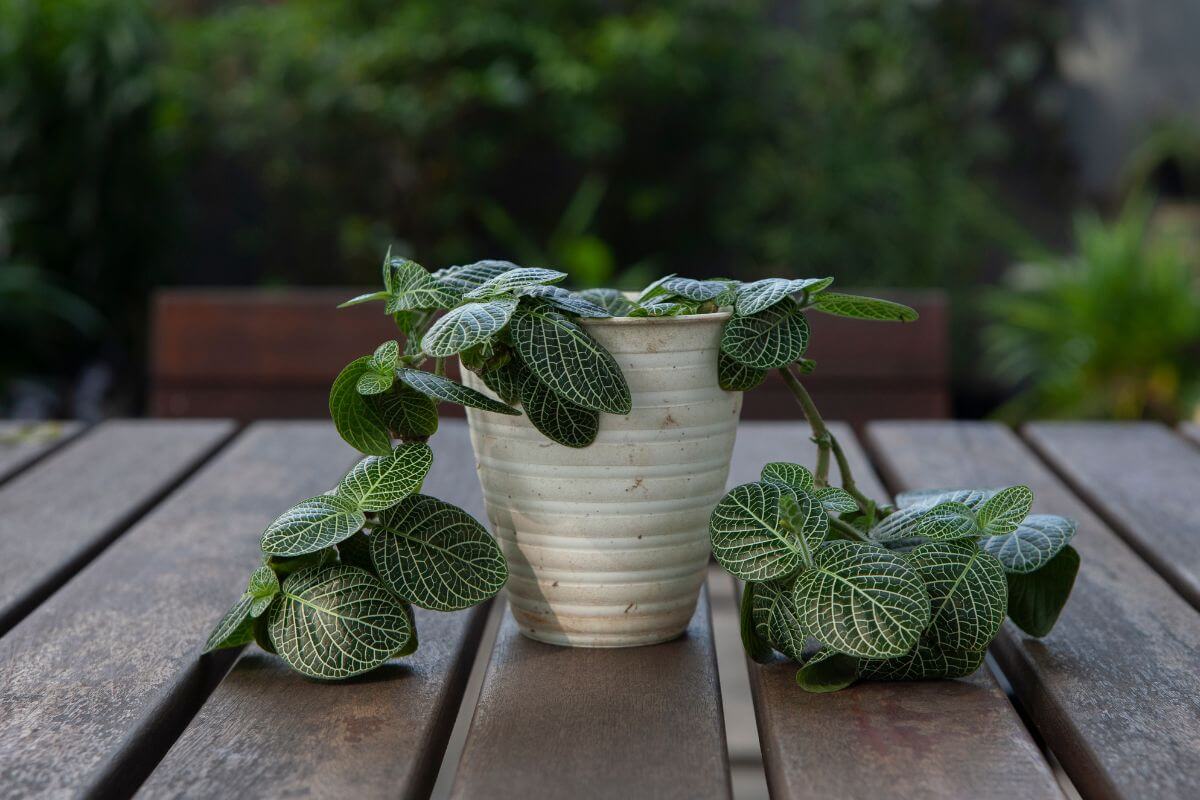The nerve plant is an evergreen perennial that’s a popular tropical houseplant for its unique, colorful leaves featuring nerve veins.
- Related: Houseplant Types
Nerve plants are easy to care for and grow. This article will cover how to care for the nerve plant and everything else you’d want to know.
Nerve Plant Overview

Fittonia albivenis, popularly known as the Nerve plant, is a member of the Acanthaceae Acanthus family. The Fittonia name comes from the two botanists that discovered it in the 19th century, Elizabeth and Sarah May Fitton.
Other names for the Nerve Plant include Mosaic Plant, Painted Net Leaf, Painted Leaf Plant, Snakeskin Plant, and Silver Nerve.
Featuring vivid green leaves with veins in various colors such as silver-white color, green, red, and pink, this plant is incredibly popular because its leaves are so colorful. It will also do well in low-light environments.
The nerve plant is a creeping plant that is low-growing and is often found in terrariums, as it will only grow to a height of three and six inches tall.
Due to its small size, it’s perfect for nooks and crannies in any home or office. But it still spreads pretty well, as much as 12 to 18 inches wide.
The nerve plant does exceptionally well in hanging baskets and terrariums, as well as in pots and containers on tables or shelves.
As an indoor houseplant, the nerve plant will most likely not flower. However, in some areas, such as USDA zone 11, you may find it growing as ground cover outdoors where sunlight is filtered. This plant calls South American rain forests home, particularly in Peru.
Nerve Plants can be found in several varieties, including:
- Argyroneura – Dark green-tinted leaves with silvery veins
- Fortissimo – Green leaves with red or pink veins
- Frankie – Leaves with light pink as the dominant color as opposed to green
- Leather Leaf – White leaves with white veins
- Mini Superba – Large leaves with pink veins
- Pearcei – Dark green foliage with red veins
- Purple Vein – Dark green leaves with purple veins
- Red Star – Leaves with pinkish-red veins
Nerve Plant Care Guide
Nerve plants have oval or elliptic leaves that grow two to four inches in length. Generally, a shade of olive green, it is renowned for bright colorful veins on its leaves. The leaves sprout in pairs on opposite sides facing each other.
While unlikely to flower indoors, this plant produces white or reddish tinted bract spikes that then flower into petite white or yellow blooms that have no scent.
A single plant will have a short life, dying back after a few years.
Soil for the Nerve Plant
The Fittonia likes the same type of potting soil mix as an African Violet. Peat or Coco Coir mixtures are ideal because they retain moisture, but are still well-draining.
Light for the Nerve Plant

The Fittonia is a tropical plant that in its native habitat, will thrive in a humid environment with shaded bright light.
It does not like direct sunlight, rather it prefers bright indirect light, so a north-facing window is ideal.
Direct light will cause leaves to shrivel. It is also at risk of leaf scorching from direct sunlight that is too strong.
Nerve plants can still thrive when placed under fluorescent lights. As a low-growing plant on jungle floors, low lighting will be a key to success in growing the Fittonia.
Temperature for the Nerve Plant
An indoor nerve plant likes the temperature range to be between 65° and 75° Fahrenheit. Do not let the temperature fall below 60°F or you could run into plant issues.
Water and Humidity for the Nerve Plant
The Fittonia needs a uniformly moist soil bed, and this can be a challenge. If the soil bed dries out, the plant will collapse.
Once you water it, it will revive. However, repeated fainting episodes will stress and negatively affect the plant in the long-term. The soil bed must be well-draining as overwatering will turn leaves yellow.
This colorful houseplant likes high humidity, which explains why it is often found grown in terrariums. The humidity level should resemble that of a rain forest, so a 60 to 70% humidity level is perfect.
You can mist it daily to help prevent it from drying out. A terrarium will resolve this problem because it will maintain natural moisture levels.
The Fittonia loves a steamy bathroom, so that is an easy alternative. A humidifier is also a great option.
A pebble tray placed underneath the nerve plant can also help. The pot should sit on the tray above the waterline, so it doesn’t come into contact with the water. The pebble tray will help create a microclimate that increases humidity as the water evaporates.
A receptacle filled with water can also be placed by the plant. You can group plants close together to create a natural humidity cap.
If you need to leave for several days, you can place a plastic bag over your plant to trap humidity, so it doesn’t dry out. Try not to let the plastic touch the leaves though.
Fertilizer for the Nerve Plant
Feed your Nerve Plant weekly during the growing season with weak diluted liquid fertilizer for tropical plants or monthly at full strength.
5-5-5 Balanced fertilizer at half strength is an appropriate feed. A Fittonia should be fed at least twice annually.
Pruning and Potting the Nerve Plant

The nerve plant is quick-growing if cultivated in the right environment. If you find stems becoming leggy, or find dead or damaged leaves, you can prune them.
Pruning and pinching off flower buds and stems will also encourage bushy growth.
The nerve plant should be repotted annually due to shallow root systems in the springtime or early summer with fresh potting soil. The pot should always have sufficient drainage holes.
Propagating the Nerve Plant
Nerve plants can be easily propagated with leaf cuttings in late spring or early summer. Take advantage of the stem cuttings while you’re also repotting.
Here’s how to propagate the nerve plant:
- Using a pair of clean garden shears, cut a stem length of two to four inches with a couple of growth nodes.
- Place the cutting in peat-based potting mix in a warm (75°-85°F) and humid location covered with plastic.
- Cuttings will sprout roots in a couple of weeks.
- Remove the plastic when roots appear.
You can also place a fresh pot of soil next to the parent plant. As a spreader, it will grow to the new pot and take hold. Just snip the vine between the two plants.
Nerve Plant Common Plant Pests, Diseases, and Problems

Pests common to most houseplants can also disturb the health of your nerve plant. These include mealybugs, fungus gnats, and especially aphids.
Pest control with an organic insecticide like neem oil should resolve the problem. However, infected plants should be isolated from other houseplants to avoid spreading the infestation.
Other problems and reasons include:
- Dry, shriveling foliage – Humidity level is too low or your Fittonia is receiving too much direct sun exposure. This can also be due to too much salt in the soil. Drench your plant until the draining water runs clear.
- Leaves dropping – Dropping foliage indicates the temperature is too cold. If you think the temperature isn’t that cold, check for cold drafts.
- Brown leaves – Dry air or dry soil.
- Yellow leaves – Overwatering! Soggy soil or insufficient drainage will be the cause.
- Gray mildew on foliage – Dry environmental conditions.
- Snails or slugs – Outdoors. If you notice holes in foliage, its probably these pests. Remove them manually.
Diseases to be on the lookout for include:
- Mosaic Virus
- Leaf spot
- Root Rot
Nerve Plant Toxicity and Pets
The Nerve Plant is non-toxic to cats and dogs, so there are no poisoning concerns for your pets.
Nerve Plant Care Final Thoughts
The nerve plant is beautiful houseplant that will decorate any home or office.
Be sure you can give it a consistently warm and high humidity environment. Placing it in the bathroom is a convenient location that will provide it the humidity.
When purchasing your first Fittonia, do so in the spring and choose a plant with smaller leaves. With the right conditions, they will thrive year round.
For more great houseplant care guides, check out some of these:
Nerve Plant Care FAQs
Are nerve plants easy to care for?
Nerve plants can be finicky, but once you get accustomed to their needs, they can be easy to care for. They require consistent moisture and warmth. The best way to ensure this is by placing them near a window where they receive bright, indirect sunlight. You may need to use a misting system if you live in a dry climate.
Why is it called a nerve plant?
The nerve plant gets its common name from its variegated foliage that resembles veins on its leaves. The botanical name, Fittonnia argyroneura, comes from the 19th century botanists who discovered it, Elizabeth and Sarah May Fitton.
What are nerve plants good for?
Nerve plants are great for ground cover, as well as a perfect houseplant to decorate your home with. Their small size makes them ideal for indoor spaces such as bathrooms, kitchens, living rooms, offices, etc.
How do I make my nerve plants bushy?
Make your nerve plants bushy by pruning regularly. Prune and pinch off brown and yellow leaves and tips, as well as stems and flower buds. That will all encourage bushier growth.
Is the nerve plant poisonous?
No, the nerve plant is not poisonous. It’s safe to grow in homes with cats, dogs, and children.


